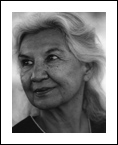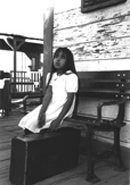INTERVIEWS:
Rattlesnake Mesa
By EdNah New Rider Weber
Illustrations by Richela Renkun


Author, EdNah New Rider Weber (left) and Photographer, Richela Renkun
Rattlesnake Mesa: Stories from a Native American Childhood is a true account of a spirited Native American girl’s experiences growing up on a reservation and attending the Phoenix Indian School in the 1920s. While working on the project, the author and photographer took a trip to New Mexico to visit Crown Point, where EdNah New Rider Weber had lived and created many of the memories in this book. What began as a trip to secure photographs for Weber’s stories quickly became a moving journey into the past. In this interview author EdNah New Rider Weber and photographer Richela Renkun talk about their journey to Crown Point and what working on this book meant to them.
What was it like to visit Crown Point?
ENRW: We did not go to Crown Point to find stories or dredge any up —most of them had already been written in 1964 and filed away in a metal box! We went there to take photographs of the places where these stories took place. We had a vision — a book, with my stories and Richela’s photography. Some of the most memorable moments were also the saddest. The Crown Point that I had known as a child no longer existed. Landmark buildings had completely vanished. The schoolhouse, a large two-storied structure, made of great stonework, was missing. . . down to its very foundation. Not a trace remained of the children’s dormitories. Later I thought that this was good since so many bad things had gone on in these places. The few buildings that were left had fallen and collapsed into themselves. I thought, My God, right here were the very sidewalks that Naneh, Little Fat and I had run, played, and learned to skate on in our youth. Although the memories were powerful and at times sad, we also made some beautiful new ones. We were always running to catch the perfect lighting for photographs and we did. Didn’t we? We also caught gorgeous skies filled with shimmering rainbows and dark skies laden with snow. From the night skies we could almost grasp ourselves a star.
stories took place. We had a vision — a book, with my stories and Richela’s photography. Some of the most memorable moments were also the saddest. The Crown Point that I had known as a child no longer existed. Landmark buildings had completely vanished. The schoolhouse, a large two-storied structure, made of great stonework, was missing. . . down to its very foundation. Not a trace remained of the children’s dormitories. Later I thought that this was good since so many bad things had gone on in these places. The few buildings that were left had fallen and collapsed into themselves. I thought, My God, right here were the very sidewalks that Naneh, Little Fat and I had run, played, and learned to skate on in our youth. Although the memories were powerful and at times sad, we also made some beautiful new ones. We were always running to catch the perfect lighting for photographs and we did. Didn’t we? We also caught gorgeous skies filled with shimmering rainbows and dark skies laden with snow. From the night skies we could almost grasp ourselves a star.
RR: Our trip out west to take photographs and seek out some of the places in EdNah’s stories was incredible. I guess the most poignant memory for me was the day we drove into Crown Point. The school and the beautiful grounds had vanished. There was no sign of the homes and cottages that EdNah remembered so well. We tried to seek out people who might remember or have knowledge about the history of the area, but no one knew anything. It was haunting, as if the whole thing had been a dream. EdNah seemed so sad. It was as though her past had been swept away by the desert wind. Then I spotted something. On the side of the road there were two brick pillars. Together they formed an entryway, but to what? Beyond these gates there was nothing but huge lot full of overgrown weeds, brush and discarded snack wrappers. EdNah was convinced that this had nothing to do with the Crown Point that she remembered. I wanted to take a closer look. “This was the entry to something,” I told EdNah. “Something big, something important, and something long ago.” We both became excited and began to search around. We noticed that the walk had been partly covered over by vegetation and soil but had not disappeared. Shells of abandoned cottages that had once served as the homes of friends and neighbors stood along the outside margin of the walk. Memory after memory came back to EdNah and she told a story about each one. We saw the shaggy remains of the beautiful park-like grounds that EdNah’s father had once cared for. So many emotions filled us at this moment. As we walked back to the car, my gardener’s eye spotted something shyly poking its way through the brambles — flowers, domesticated flowers that someone had planted long ago; maybe even EdNah’s father. I felt truly overwhelmed. We had found what we came for.
What kind of research (if any) did you conduct for this project?
ENRW: I did the stories from memories of what actually happened. It’s funny, because in my youth we did not have television, computers, cell phones, or email to compete for our minds. The children of today seem like little wizards of space, communicating between other worlds. But the older Native American who read or hear the stories do give them a strong affirmation! Many have had very similar happenings. But most of the old boarding schools have closed and today children are in a different time warp.
RR: On my first trip out west we began simply with a map, some notes, the stories, and a lot of enthusiasm. We drove through the west looking for visuals that inspired and reminded us of EdNah’s stories. It was a beautiful adventure. After that I stationed myself in Tucson with EdNah. Working from there I made contacts and sought out individuals to pose for the portraits in the book, always relying on EdNah’s work as inspiration. I also read several documents on the early Indian school systems, but my main source of guidance came from EdNah herself.
What do you like most about the book?
ENRW: I like the entire production of the book. It is much nicer than I ever imagined . . . from the slick paper to the gorgeous photography, done with a clever eye by Richela. I feel very humbled that anyone could so honor our work in this exceedingly fine way. I do wish to thank Jennifer Fox, our editor, for using a delicate hand in preserving the work details. The laundry, serving rooms, dining hall, and dorm details . . . she could have brushed these stories aside as trivial, but recognized their importance to the story.
RR: What I like most about this book is that EdNah’s stories will be shared and never lost. Also, it brings to fruition all the work and love that both EdNah and I put into this endeavor. It will always be for me a testament to the days and years spent working together on this project.
Why do you think that it is important to tell this story?
ENRW: Perhaps it’s not important to anyone at all. But as I said before, many of the older Native Americans who read and affirmed the stories had similar happenings. Most of these grandparents speak English, learned in their youth at the boarding schools. The parents, most of them have high school behind them and most of them hold some kind of a job. Their children, today’s children have their eyes on college or military or trade school. Each generation has stepped up a step, but we won’t forget where we came from.
RR: I think these stories are incredibly important because they give an intimate look into a part of American history that so little is known about. The fact that EdNah’s perspective comes from first-hand knowledge is also of serious recognition. And yet EdNah’s voice is so readable, not angry, not bitter, nor blaming or blandly biographical. She is a true storyteller. As for the photographs in the book, I think that for many it will be a fresh look at the Native American face—less stoic and more human.
About This Title
Guided Reading:
YLexile:
760LInterest Level:
Grades 4 - 12Reading Level:
Grades 4 - 5Themes
Nonfiction, Middle Grade, YA interest, Identity/Self Esteem/Confidence, Overcoming Obstacles, Native American Interest, Friendship, Environment/Nature, Discrimination, Coping with Death, Childhood Experiences and Memories, Biography/Memoir, Empathy/Compassion, Persistence/Grit, Courage, Dreams & Aspirations, Families, Grandparents, History, Home, Poverty, Self Control/Self Regulation, United States History
Collections
Poetry Middle School, Biographical Poetry High School, Biography and Memoir Middle School, Biography and Memoir High School, Nonfiction Collection Middle School, Nonfiction High School Collection, Diverse Background English Collection Middle School, Diverse Background English Collection High School, Native American English Collection High School, Fluent Dual Language , Fluent English, Biography and Memoir Grades 3-6, Native American English Collection, Native American English Collection Grades 3-6, Poetry Grades 3-6, Nonfiction Grades 3-6, Native American Heritage Collection, Appendix B Diverse Collection Grades 3-6, Women's Text Set Collection Grades PreK-8, Women's Text Set Collection Grades 6-8, Native American Collection English 6PK, English Guided Reading Level Y, Trauma-Informed Collection, Native American and Indigenous Booklist , High-Low Books for Teens: Middle and High School
More Info
Want to know more about us or have specific questions regarding Interviews?
Please write us!
general@leeandlow.com










